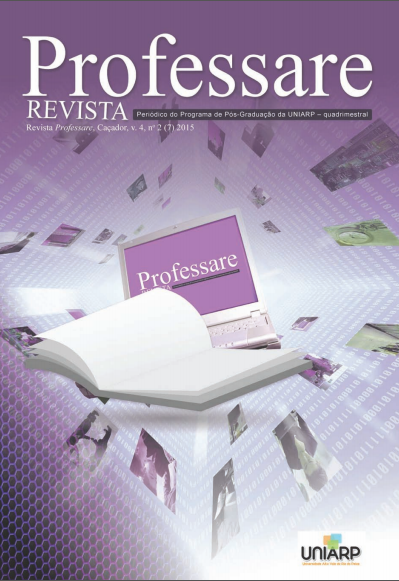COMUNICAÇÃO ENTRE PROFESSOR E ALUNO EM SALA DE AULA: O USO DAS DIVERSAS LINGUAGENS NA FORMAÇÃO DE CONCEITOS MATEMÁTICOS
DOI:
https://doi.org/10.33362/professare.v4i2.643Resumo
O presente artigo tem por objetivo aprofundar a reflexão sobre o Pacto Nacional de Alfabetização na Idade Certa (PNAIC), criado pelo governo federal para garantir a alfabetização no primeiro ciclo do ensino fundamental. Diante da complexidade da questão, e buscando compreender a relação entre a teoria e a prática, levantamos os seguintes questionamentos: Em que medida a formação do PNAIC vem contribuindo para instrumentalizar a prática do professor alfabetizador na construção e elaboração dos conceitos matemáticos? E como a linguagem utilizada na sala de aula contribui para a aprendizagem matemática? O estudo divide-se em três partes: a primeira apresenta a história da criação do PNAIC e seus objetivos; a segunda parte discute a utilização da linguagem matemática para a alfabetização das crianças no primeiro ciclo de alfabetização, de acordo com pesquisas realizadas por Belfort e Vergnaud. A terceira traz um aprofundamento sobre a importância do uso da linguagem para a formação dos conceitos no ensino da matemática. Analisa também como o conceito ajuda na aprendizagem das crianças no ciclo de alfabetização e como o programa ajuda nesse contexto.
Palavras-chave: Linguagem matemática. Conceitos. Alfabetização. Aprendizagem.
COMMUNICATION BETWEEN TEACHER AND STUDENT IN THE CLASSROOM: THE USE OF VARIOUS LANGUAGES IN THE DEVELOPMENT OF MATHEMATICAL CONCEPTS
ABSTRACT
This article aims to deepen the reflection on the national literacy Pacto Nacional de Alfabetização na Idade Certa (PNAIC), created by the federal government to ensure literacy in the first cycle of basic education. Considering the complexity of the issue and trying to understand the relationship between theory and practice, we raise the following questions: To what extent the formation of PNAIC has contributed to instrumentalize the practice of literacy teacher in the construction and development of mathematical concepts? And as the language used in the classroom contributes to the learning of mathematics? The study is divided into three parts: the first presents the history of the creation of PNAIC and its objectives; the second part discusses the use of mathematical language to children’s literacy in the first literacy cycle, according to the research carried out by Belfort and Vergnaud. The third brings about a deepening of the importance of language use for the formation of concepts in mathematics education. It also analyzes how the concept helps children’s learning in literacy cycle and how the program helps it on this context.
Keywords: Mathematical language. Concepts. Literacy. Learning.
Downloads
Publicado
Como Citar
Edição
Seção
Licença
Autores que publicam nesta revista concordam com os seguintes termos:- Autores mantém os direitos autorais e concedem à Revista o direito de primeira publicação, com o trabalho simultaneamente licenciado sob a Licença Creative Commons Attribution que permite o compartilhamento do trabalho com reconhecimento da autoria e publicação inicial nesta Revista.
- Autores têm autorização para assumir contratos adicionais separadamente, para distribuição não-exclusiva da versão do trabalho publicada nesta Revista (ex.: publicar em repositório institucional ou como capítulo de livro), com reconhecimento de autoria e publicação inicial nesta Revista.
- Autores têm permissão e são estimulados a publicar e distribuir seu trabalho online (ex.: em repositórios institucionais ou na sua página pessoal) a qualquer ponto antes ou durante o processo editorial, já que isso pode gerar alterações produtivas, bem como aumentar o impacto e a citação do trabalho publicado (Veja O Efeito do Acesso Livre).









